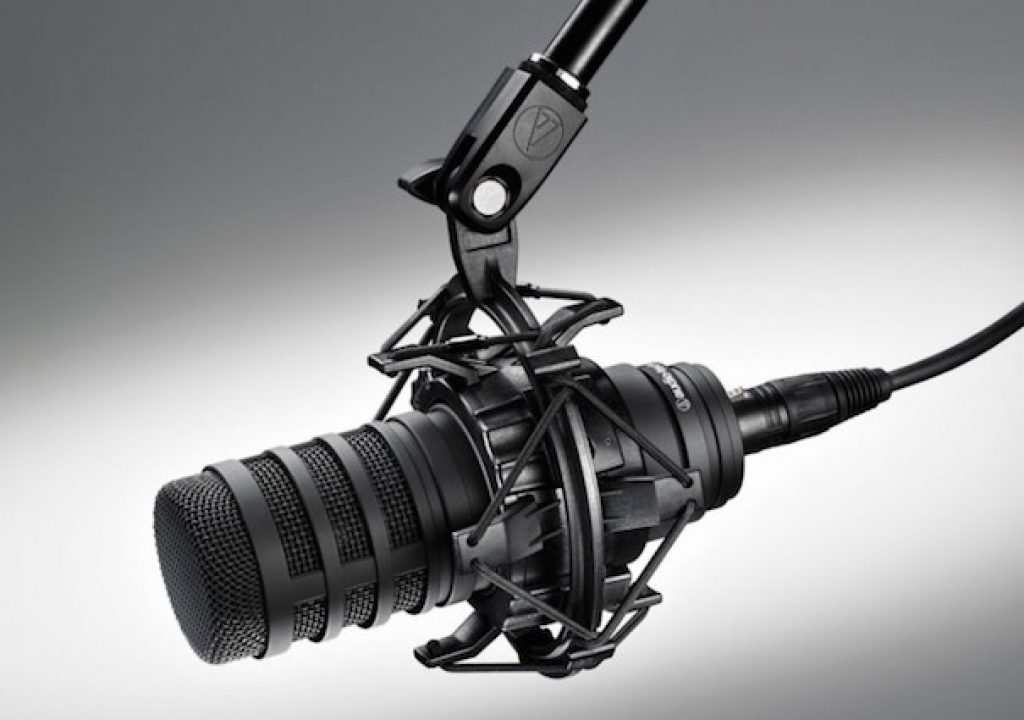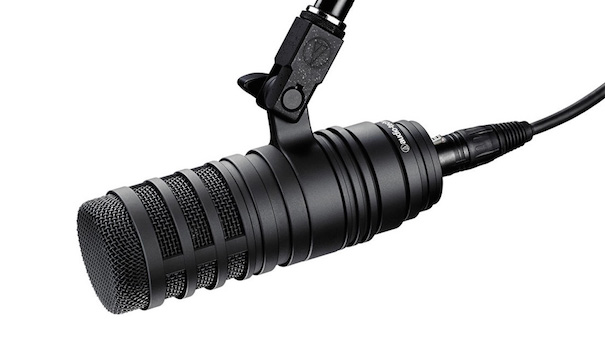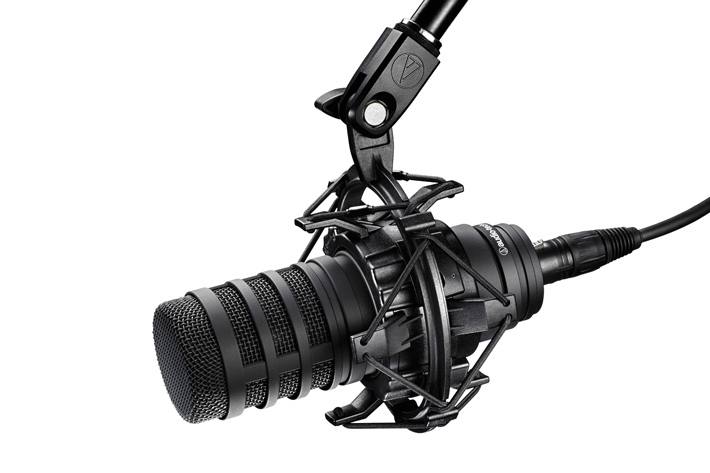
I am privileged to be among the first tech journalists/consultants to review the just released Audio-Technica BP40 high-end dynamic analog studio microphone. As I have covered in the past, dynamic microphones are among the most popular ones used in traditional terrestrial AM/FM radio and by podcasters, as well as being the most popular type for handheld television ENG (Electronic News Gathering) interviews. Ahead I’ll review the differences between dynamic and condenser mics, as well as between analog-only, hybrid, and digital-exclusive categories. Then I’ll cover the BP40, its optional AT8484 shockmount… and recordings.
Dynamic versus condenser microphones
How do they basically compare?
Condenser (aka capacitor or electrostatic) microphones require power, either from an internal battery or via phantom power supplied by the audio mixer or from an in-line phantom power supply. (Some unbalanced condenser microphones use bias voltage aka plugin power, instead of phantom power.) Compared with dynamic microphones, condenser microphones are considered more sensitive, have a slightly higher output, yet are more fragile. With the exception of some specialized microphones (most lavalier microphones, shotgun microphones, some head mounted microphones, and some boundary microphones), condenser microphones are more common in recording studios than in the field or even in a radio booth.
Dynamic microphones do not require power, and are considered to be more robust than equivalent condenser microphones. They are very common in radio booths and for handheld interview situations both for radio and TV. Some dynamic microphones have built-in shock absorbers.
Why many prefer a dynamic and not a condenser microphone for home or office recordings?
Condenser microphones are more fragile and more sensitive. That’s why they are best used in an isolated sound booth if at all possible, without reverberation. If you were to use most condenser microphones at your home, apartment, or office without an isolated sound booth or other acoustic treatment, you’d likely notice that it has a tendency to capture much more of the ambient sound, including the street sound, air conditioning, and the refrigerator. That’s why for home and office recording it’s often recommended to use a high-quality dynamic microphone, with a cardioid pattern (semi-directional) and to speak very close to the microphone. Having said that, if you get close enough and speak loudly enough to be able to set the input level low enough, you may be able to get away with using a condenser microphone in a home or office environment, but it is more challenging.
The myth about dynamic mics… and the truth
There is a myth that states that dynamic microphones don’t have professional quality or broadcast quality. The reality is that most microphones used in radio booths are dynamic… and most handheld microphones used in broadcast TV news are also dynamic. The technology of dynamic microphones has drastically improved. Nowadays, there are both good and bad microphones of both technology type, but being good or bad is not intrinsic to the technology type, but to the particular model, and the application. Naturally, most dynamic microphones have a lower output level than condenser mics. That’s why sometimes when people have a mediocre preamplifier without realizing it (since they’ve always used it with a condenser microphone in the past), they become unsatisfied with the quality of a dynamic mic they connect and test, and incorrectly blame the dynamic mic, when the true villain is the mediocre preamp that has previously seemed good since it has always received a relatively high level and therefore has practically spent its life sleeping, and perhaps was mainly used before more as an A-to-D (analog-to-digital) converter.
Analog-only versus digital versus hybrid microphones
This section is to show how dynamic mics overlap into three categories of connectivity, and how condenser mics overlap into at least two:
Dynamic mics across all three connectivity categories
Dynamic microphones exist as analog-only, for example: the Audio Technica BP4002 (reviewed here); the Audio Technica BP40 (reviewed in this very article); the Heil PR40 (covered here and here); the Electro-Voice EV635, RE20 and RE50; the RØDE Reporter; and the Shure SM58 and SM7. Analog-only microphones can be plugged directly into professional camcorders, professional audio & video recorders, and into audio mixers. Analog microphones can also connect to computers, sometimes directly (not generally recommended) or via external peripherals, which can be via an audio mixer with a USB output or via a preamp/A-to-D (analog-to-digital) converter. As a result, analog microphones are connectable to any device, although sometimes they require an extra interface if not already present. The number of different models and varieties of analog-only microphones available on the market is much greater than any of the other two categories I’ll cover ahead, and analog-only microphones have existed since way before you or I were born, and they continue to flourish. From a historical perspective, the other two categories explained ahead are very recent.
Dynamic microphones also exist as hybrid (both analog XLR and USB digital output). The most notable hybrid microphones are the consumer Audio Technica ATR2100 and professional version AT2005USB —both shown here:
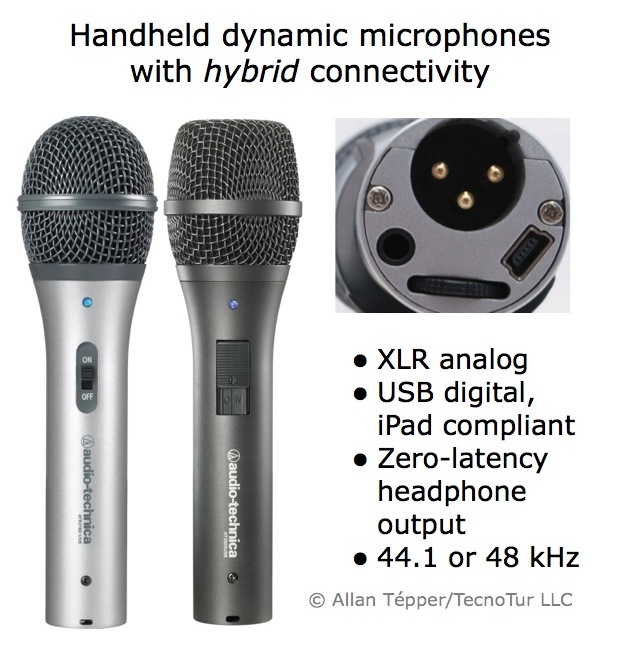
…illustrated by the graphic I created when I first reviewed them both here in ProVideo Coalition magazine back in 2012, part 1 and part 2. I later covered them in several other articles and ebooks. As indicated above, the analog XLR output of a hybrid mic can be plugged directly into professional camcorders, professional audio & video recorders, and into audio mixers… while their digital output can be plugged directly into a computer via USB, and —in many cases— to a tablet or phone via Lightning with Apple’s iOS devices, or USB OTG with Android. The digital output is present thanks to the built-in preamplifier and A-to-D (analog-to-digital) converter. As a result, hybrid microphones can be connected to virtually any device. However, there are very few such microphones on the market to date, exponentially fewer than there are analog-only models.
Finally, dynamic microphones exist in digital-only models like the RØDE Podcaster, shown here:
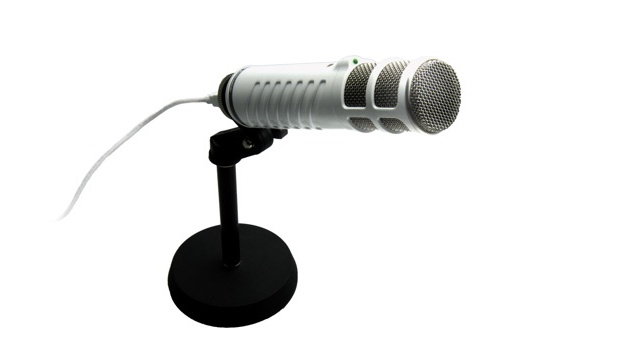
Although digital-only microphones can be connected to computers, and in some cases to tablets and phones, digital-only microphones cannot be connected to any professional camcorder, professional audio & video recorder, or any audio mixer I have ever seen. This makes digital-only microphones much more restrictive in terms of connectivity than analog-only or hybrid microphones. Using special software and configurations, it is now possible to connect multiple digital-only microphones directly to a computer (although with some “gotchas”), which is a topic to be covered in an upcoming article about multitrack recording.
Condenser mics across all three connectivity categories
Like dynamic microphones covered just before in this article, condenser microphones exist as analog-only, i.e. the RØDE PinMic lavalier microphone (reviewed here) and shown here:

….and the Shure Beta 87A (covered briefly in this article). As indicated in more detail above, analog microphones are connectable to any device, although sometimes they require an extra interface if not already present.
So far, I don’t recall having seen any condenser hybrid mics (with XLR analog and digital output), but they may exist or be released in the future.
Finally, condenser mics exist in many digital-only versions, including several that I have reviewed, like the IK Multimedia iRig Mic HD (reviewed here) and shown here:
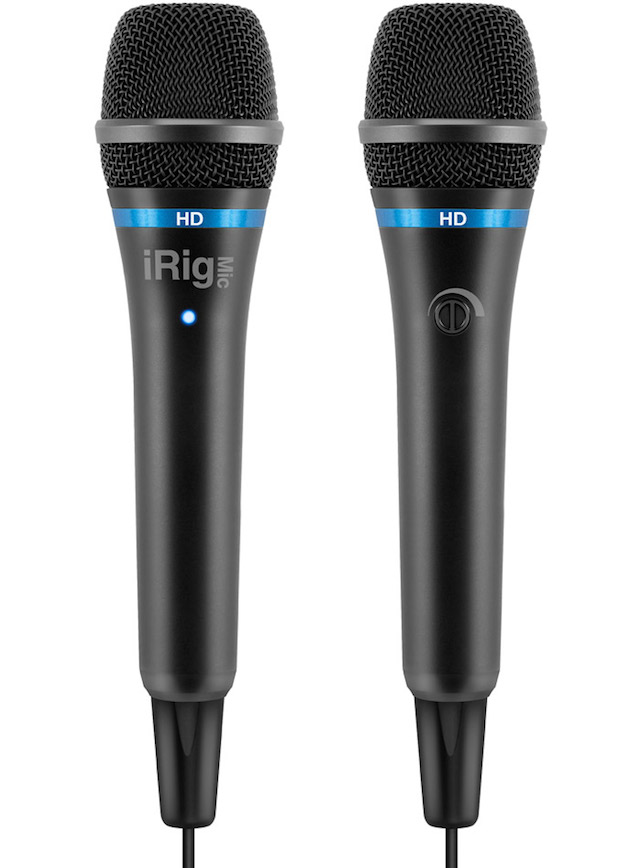 <
<
…the iRig Mic HD-A (Android version reviewed here), the IK Multimedia iRig Field stereo mic & the RØDE i-XY-L stereo mic (both reviewed and compared here), and the RØDE NT-USB (reviewed here) and shown here:
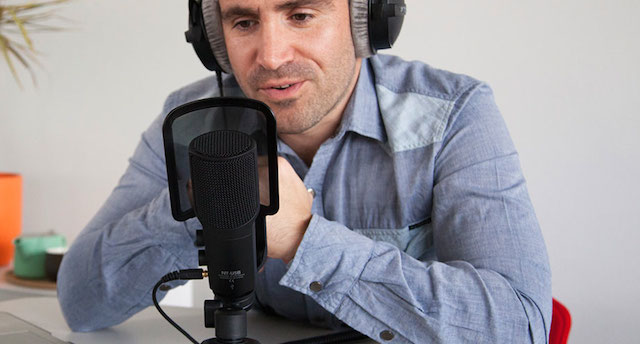
As indicated above, although digital-only microphones can be connected directly to computers, and in some cases to tablets and phones, digital-only microphones cannot be connected to any professional camcorder, professional audio or video recorder, or any audio mixer I have ever seen. This makes digital-only microphones much more restrictive in terms of connectivity than analog-only or hybrid microphones. Using special software and configurations, it is now possible to connect multiple digital-only microphones to a computer (although with some “gotchas”), which is a topic to be covered in an upcoming article about multitrack recording.
All about the BP40 from Audio Technica
In the photo above, you’ll see the BP40 as it comes with a mount but without the optional shockmount.
From the manufacturer
Here is the description from the manufacturer:
The BP40 broadcast vocal microphone offers a rich, natural, condenser-like sound from a large-diaphragm dynamic design. The large diaphragm features patented floating-edge construction that maximizes diaphragm surface area and optimizes overall diaphragm performance, while the humbucking voice coil prevents electromagnetic interference (EMI). With rugged construction and stylish, waveform-inspired design, the BP40 delivers clear and articulate reproduction. Optimized capsule placement helps maintain a commanding vocal presence even at a distance, while the multistage windscreen provides superior internal pop filtering. The BP40 also includes a switchable 100 Hz high-pass filter to provide even more pop protection.
Published specifications and comments
Element technology: Dynamic (See dynamic versus condenser earlier in this article.)
Element diameter: (not published, but supplied after inquiry): 37 mm (approximately 1.46 inches)
Polar pattern: Hypercardioid (See my prior articles regarding cardioid versus omnidirectional patterns. Hypercardioid is more directional than cardioid, but less than a shotgun, and rejects off axis sounds more than a cardioid.)
Frequency response: 50–16,000 Hz
Open circuit sensitivity: –48 dB (3.9 mV) re 1V at 1 Pa
Impedance: : 450 ohms
Switch: Flat, roll-off
Weight: 632 grams (22.3 ounces)
Dimensions: 164.0 mm (6.45 inches) long, 56.0 mm (2.20 inches) diameter
Output connector: Built-in 3-pin XLR male
Included accessories: AT8483 mounting clamp for 5/8“–27 threaded stands; 5/8”–27 to 3/8“–16 threaded adapter; soft protective pouch
Warranty: Five-Year limited to the end-user
Optional accessory: AT8484 shock mount for 5/8”–27 threaded stands
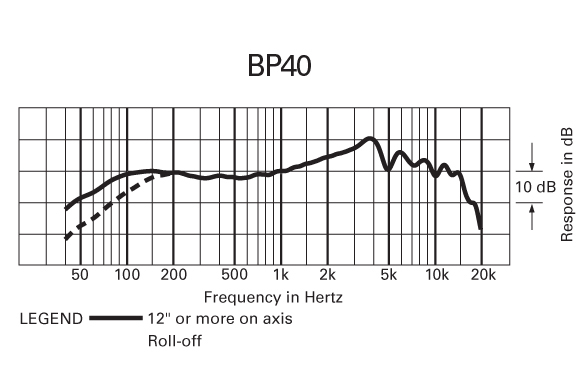
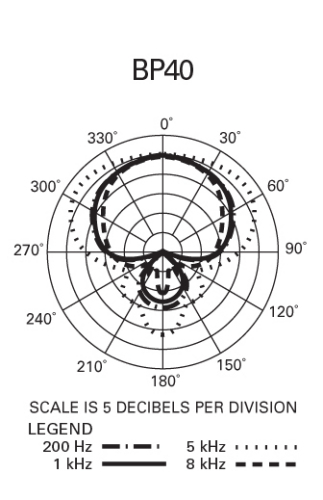
Physical beauty
The physical look of the BP40 moves me even more than those modern studio microphones made to imitate the Elvis Presley style,
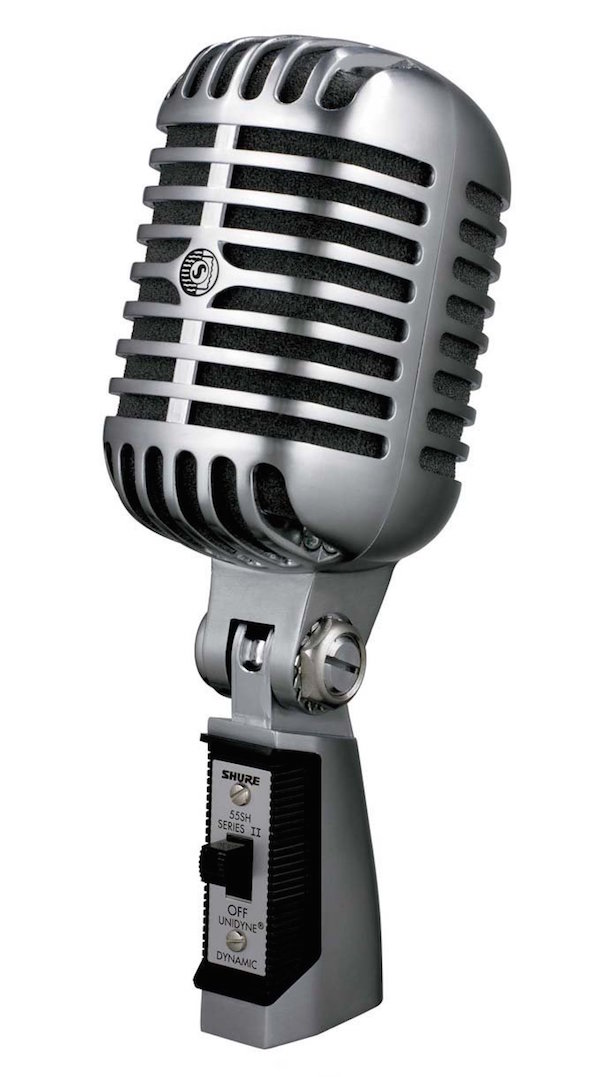
…like the Shure 55SH Series II (shown above) or Heil’s The Fin, both of which are also dynamic and analog-only, as is the BP40.
In the world of aviation, I would say that the BP40’s appearance is analogous to the legendary aircraft presumably called TR–3A (or TR–3B) Black Manta, allegedly of the United States Air Force and speculated to be developed under a black project. Because of the intriguing appearance and apparent secrecy of the legendary craft, witnesses have often assumed it to be of extraterrestrial origin. But unlike the intriguing yet unobtainable TR–3A (or TR–3B) Black Manta, the BP40 from Audio-Technica is actually available for purchase by mere civilians for a street price of US$349 as of publication time of this article.
The optional AT8484 shockmount
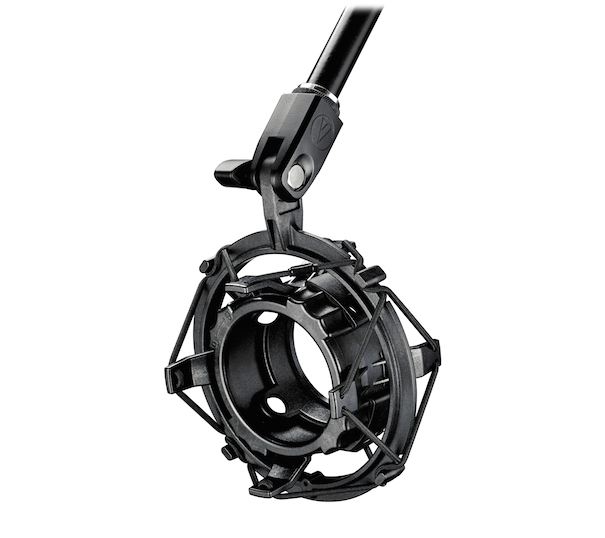
As an optional accessory, Audio-Technica offers the AT8484 shockmount specifically for the BP40.
- Attenuates noise, shock and vibration transmitted through mic stands, booms and mounts.
- Inner shock mount ring rotates to engage ball bearings that lock microphone in place.
- Compatible with 5/8″–27 threaded stands.
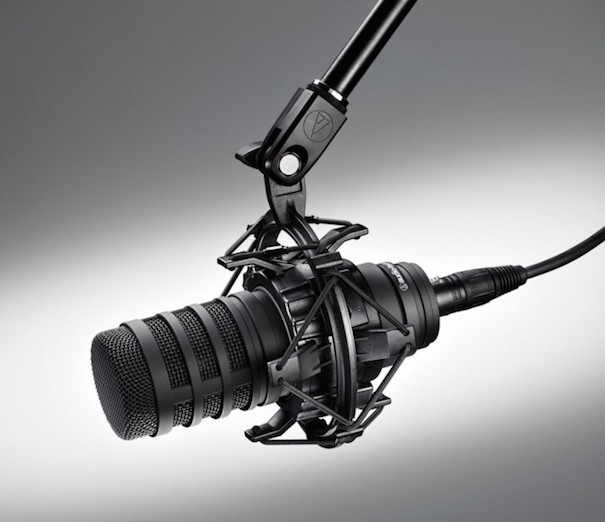
I found the AT8484 shockmount very simple to mount onto my Heil PL–2T broadcast boom, and it complements the esthetic look of the BP40 very well. The AT8424 has a street price under US$100.
Audio recordings
Rather than making the traditional side-by-side comparisons as I typically do, in this initial review article, I recorded three segments for episode 7 of my CapicúaFM show using the BP40, while other segments were previously recorded with several other microphones (details ahead). This is the episode where I interviewed interpreter/translator Gio Lester, who is President of ATIF (Association of Translators and Interpreters of Florida, United States)…

…and promoted my online petition for Apple to fix the spelling of its upcoming operating system OS X El Capitán.
Here is a very simplified rundown of the episode which clarifies which microphones were used in each of various segments:
- 00:00–00:06 Testimonial by Ana Cifuentes in an outdoor location: IK Multimedia iRig Mic HD-A for Android (reviewed here) using its own preamp and A-to-D converter.
- 00:06–00:39 Uber spot performed by María Esnoz in her studio in Spain: Shure SM58.
- 00:40–1:00 Tease delivered by Allan Tépper in the CapicúaFM/TecnoTur studio: Audio Technica BP40 (reviewed in this very article) via the iRig Pro preamp/A-to-D converter (reviewed here).
- 1:00–1:42 Opening sequence performed by Víctor Martorella with the Neumann U87A via a Focusrite Red 7 preamp/compressor/limiter/de-esser/exciter, and by Victoria Mesas García in her studio in Spain with an Audio Technica AT2005USB (covered in several of my articles and ebooks) using its own preamp and A-to-D converter.
- 1:42–5:03 First block about Apple’s misspelling of El Capitán and appeal for listeners to sign the online petition, delivered by Allan Tépper in the CapicúaFM/TecnoTur studio: Audio Technica BP40 (reviewed in this very article)
- 5:03–5:36 Uber spot as indicated earlier, performed by María Esnoz in her studio in Spain.
- 5:36–6:06 Spot 1 for the books La conspiración del castellano and The Castilian Conspiracy, performed by Humberto Rossenfeld, Marie Colom, and Víctor Martorella with the Neumann U87A via a Focusrite Red 7 preamp/compressor/limiter/de-esser/exciter.
- 6:06–6:13 Bumper return from spots, performed by Victoria Mesas García in her studio in Spain with the AT2005USB and its own preamp/A-to-D converter.
- 6:13–21.50 Block 2: Conversation between Gio Lester and Allan Tépper: pair of AT2005USB hybrid microphones using its analog XLR outputs which fed independent inputs of the Tascam DR–60DmkII audio recorder (reviewed here).
- 21:50–21:58 Bumper to commercial spots, performed as a duo by Víctor Martorella and Victoria Mesas García as indicated earlier.
- 22:00–22:30 Spot 1 for the books La conspiración del castellano and The Castilian Conspiracy, performed by Memo Sauceda with a Neumann 103 via a Universal Audio LA–610 preamp.
- 22:30–23:07 Uber spot (as indicated earlier)
- 23:07–23:14 Bumper back, performed by Victoria Mesas García as indicated earlier.
- 23:14–27:06 Block 3: (continuation of block 2, with same people and equipment).
- 27:06–29:04 Close delivered by Allan Tépper in the CapicúaFM/TecnoTur studio: Audio Technica BP40 (reviewed here in this very article).
In upcoming articles about other microphones, audio interfaces, and audio multitrack recording, I’ll include more sample recordings of the BP40, as well as continuing to use it for most studio recordings for CapicúaFM. EDIT: More BP40 recordings are now available in this newer article.
When to use a high-end analog studio microphone in a TV production, beyond voiceovers
Beyond the obvious case for voiceovers, there are radio shows (and audio podcasts) that are simulcast on TV or video.

One example of that is Mike & Mike (formerly Mike and Mike in the Morning), see photo above, which is a sports-talk radio show hosted by Mike Golic and Mike Greenberg on ESPN Radio and simulcast on television, and acts as the morning show for both the radio and television sides of the production. Whether you a re-purposing your audio show for video/TV distribution, or you just want the look (and superior audio quality demanded for audio-only distribution), here are cases where you would want not only a good-sounding, but also an attractive looking microphone on your video set, like the BP40.
SCM rating for the BP40
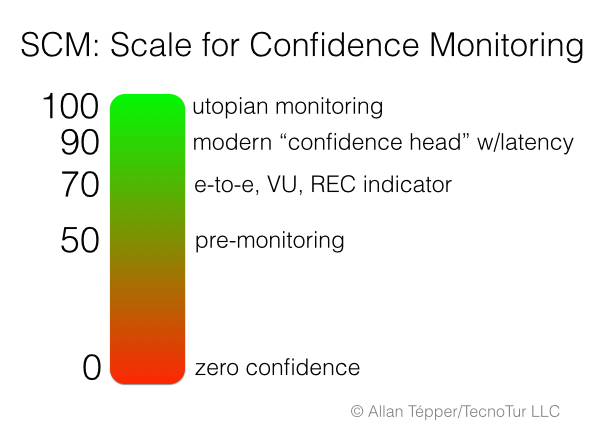
You may recall the SCM scale from my recent article called Establishing SCM: a standard Scale for Confidence Monitoring, illustrated above.
Like absolutely any analog-only microphone from any manufacturer, the SCM rating of the BP40 is zero. By their nature, with all analog-only microphones, confidence (or the lack thereof) is determined by the surrounding system, not by the microphone itself.
Conclusions
I like the BP40 very much, together with its optional AT8484 shockmount. Although the BP40 has a substantially higher street price than the AT2005USB, for a fixed, studio location (much more than for a mobile situation), the BP40 indeed produces a fuller-bodied vocal sound, and also provokes a striking visual impression for visitors, photos or videos. Unlike with the beloved AT2005USB, where I do have a couple of concrete constructive criticisms in case Audio-Technica ever decides to design a replacement model or higher-end version, with the BP40 and its optional AT8484, I don’t think I would change anything.
For several years, the AT2005USB has been my reference microphone, to which I have compared nearly all others I have reviewed, and the one that I have used for my own audio programs, where I have strived for pristine quality. The AT2005USB has also been the microphone I have used to test the quality of preamps, A-to-D converters, audio recorders and video recorders from many manufacturers. For my voice, the AT2005USB was actually a superior replacement for the Heil PR40 that I used before the AT2005USB came out to the market, at a fraction of the price of the Heil PR40. Of course, I know that the sound of a mic is a combination of several factors, including the particular voice, the environment, the processing, etc. Now, I find that my voice sounds better with the BP40 than it does with the AT2005USB, and it really looks attractive too, for a studio installation. The audio difference is not huge enough that it would make it impossible to intercut my own voice in the same episode (since there are bumpers and commercial spots to separate them). If you jump between them, you can certainly tell that one is much better than the other, but most listeners won’t be doing that. Despite the improvement, my voice sounds natural, without excessive equalization so if you were to meet me in person, you would still recognize my voice. (Some other microphones are guilty of making the voice sound unnatural.)
Upcoming articles, reviews, and books
Stand by for upcoming articles, reviews, and books. Sign up to my free mailing list by clicking here.
Si deseas suscribirte a mi lista en castellano, visita aquí. Si prefieres, puedes suscribirte a ambas listas (castellano e inglés).
Books, consulting, articles, seminars & audio programs
Contact Allan Tépper for consulting, or find a full listing of his books, articles and upcoming seminars and webinars at AllanTepper.com. Listen to his CapicúaFM program at CapicúaFM.com in iTunes or Stitcher.
My latest book (paperback + ebook)

My most recent book is available in two languages, and in paperback as well as an ebook. The ebook format is Kindle, but even if you don’t have a Kindle device, you can read Kindle books on many other devices using a free Kindle app. That includes iPad, Android tablets, Mac computers, and Windows computers. Although generally speaking, Kindle books are readable on smartphones like Androids and iPhones, I don’t recommend it for this particular book since it contains both color photos and color comparison charts. The ebook is also DRM-free.
In English, it’s The Castilian Conspiracy. Click here and you will be automatically sent to the closest Amazon book page to you based upon your IP address. Or request ISBN–10: 1456310232 or ISBN–13: 978–1456310233 in your favorite local bookstore.
En castellano, se llama La conspiración del castellano. Haz clic aquí para llegar al instante a la página del libro correspondiente a tu zona y moneda en Amazon, según tu dirección IP. De lo contrario, solicítalo en tu librería preferida con los ISBN–10: 1492783390 ó el ISBN–13: 978–1492783398.
FTC disclosure
No manufacturer is specifically paying Allan Tépper or TecnoTur LLC to write this article or the mentioned books. Some of the other manufacturers listed above have contracted Tépper and/or TecnoTur LLC to carry out consulting and/or translations/localizations/transcreations. Many of the manufacturers listed above have sent Allan Tépper review units. So far, none of the manufacturers listed above is/are sponsors of the TecnoTur programs, although they are welcome to do so, and some are, may be (or may have been) sponsors of ProVideo Coalition magazine. Some links to third parties listed in this article and/or on this web page may indirectly benefit TecnoTur LLC via affiliate programs.
Copyright and use of this article
The articles contained in the TecnoTur channel in ProVideo Coalition magazine are copyright Allan Tépper/TecnoTur LLC, except where otherwise attributed. Unauthorized use is prohibited without prior approval, except for short quotes which link back to this page, which are encouraged!

Filmtools
Filmmakers go-to destination for pre-production, production & post production equipment!
Shop Now